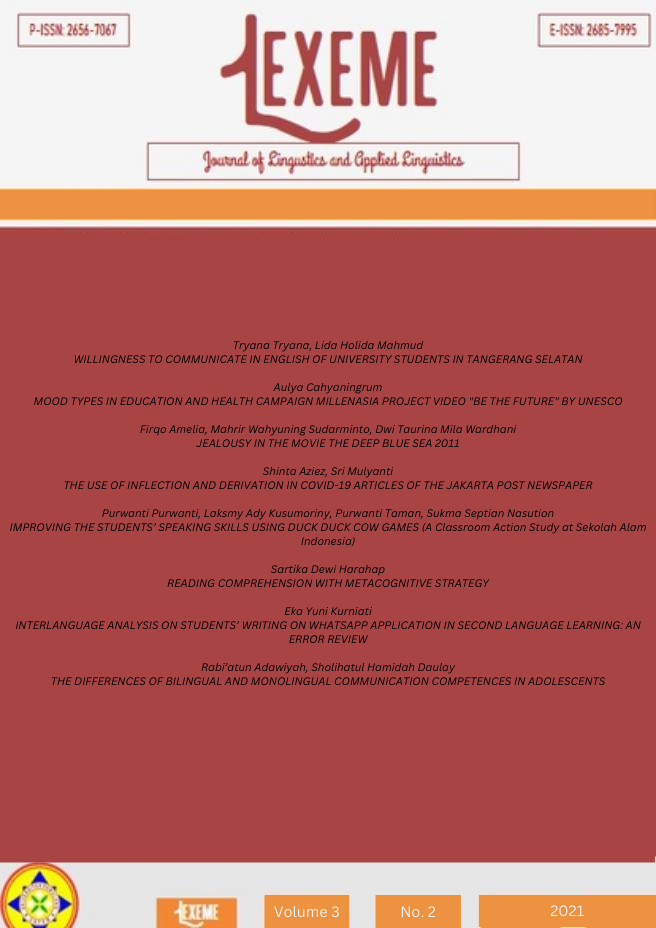JEALOUSY IN THE MOVIE THE DEEP BLUE SEA 2011
DOI:
https://doi.org/10.32493/ljlal.v3i2.18121Keywords:
defence, jealousy, protection, psychoanalysis, self-confidenceAbstract
Jealousy is close to human’s life. Human express it in different levels depending on the cause of the appearance. In this study, jealousy is analysed and exposed in the case of marriage relationship. This study is aimed to find out the cause of the jealousy phenomenon in the movie The Deep Blue Sea. This research used descriptive qualitative method to analyse deeply about jealousy depicted in the movie The Deep Blue Sea. The data analysis technique was taken from Miles ad Huberman’s theory. This psychoanalysis research used the theory of Kingham and Gordon to analyse cause of jealousy. The result showed that jealousy in the movie was caused by locus of causality, controllability and stability. Besides, the affiliation concerning jealousy and protections was considerably sturdier for males than for females. It was defined that a relationship regarding jealousy as well as self-confidence did indisputably be existent, hitherto this was simply the instance for females. For males, jealousy was originated to be essentially associated with practice of defence.References
Adams, S. (2012). Jealousy in Romantic Relationships, Self-Esteem and Ego Defenses. Melbourne: Victoria University.
Anderson, C. A., & Arnoult, L. H. (1985). Attributional style and everyday problems in living: De-pression, loneliness, and shyness. Social Cognition, 3, 16-35.
Brown, J., & Weiner, B. (1984). Affective consequences of ability versus effort ascriptions: Contro-versies, resolutions, and quandaries. Journal of Educational Psychology, 76, 146–158.
Covington, M. V., & Omerlich, C. L. (1984). An empirical examination of Weiner’s critique of attri-bution research. Journal of Educational Psychology, 76, 1199–1213.
Creswell, J. W. (2007). Qualitative inquiry and research design: Choosing among five traditions (2nd ed.). Thousand Oaks, CA: Sage.
Dewiastuti, R. (2007). A study of jealousy as reflected on leontes a major character of the winter’s tale a play by William Shakespeare (a psychological appraoch). Unpublished Research Paper, Sebelas Maret University of Surakarta, Faculty of Teachers Training and Education, Surakarta.
Endraswara, D. S. (2013). Metodologi Penelitian Sastra: Epistemologi, Model, Teori dan Aplikasi. Yogyakarta: Center for Academic Publishing Service.
Fontaine, C. (1974). Social comparison and some determinants of expected personal control and ex-pected performance in a novel task situation. Journal of Personality and Social Psychology, 29, 487-496.
Freud, S. (1959). Certain Neurotic Mechanisms in Jealousy, Paranoia and Homosexuality. In Collected Papers ( Vol. 2, pp 232-234 ). New York: Basic Books ( Original work published 1922 ).
Graham, S., Doubleday, C., & Guarino, P. A. (1984). The development of relations between perceivedcontrollability and the emotions of pity, anger, and guilt. Child Development, 55, 561–565.
Kingham, M., & Gordon , H. (2004). Aspects of morbid jealousy. The Royal College of Psychiatrists, vol. 10, 207–215.
Leahy, R. L. (2008). Cognitive Behavioral Therapy. International Journal of Cognitive Therapy.
Mardiyono, S. P. (2011). Concept Analysis of Perceived Control. Nurse Media Journal of Nursing, 1(2), 225-243.
MartÃnez-León, N. C. (2017). A systematic review of romantic jealousy in relationships. Terapia Psicologica, 35(2), 203-212.
Moleong, L. J. (2010). Metodologi penelitian kualitatif. Bandung: Remaja Rosdakarya.
Petrova, N. F. (2016). Psychological Stability of a Personality and Capability of Tolerant Interaction as Diverse Manifestations of Tolerance. International Journal of Environmental & Science Education, 11(10), 3367-3384.
Pines, A. M. (1998). Romantic Jealousy. New York: Routledge.
Rees, T. I. (2005). Attribution in Sport Psychology: Seeking Congruence between Theory, Research and Practice. Psychology of Sport and Exercise, 6, 189-204.
Ryan, R. M. (2000). Self-Determination Theory and the Facilitation of Intrinsic Motivation, Social Development, and Well-Being. American Psychological Association, Vol. 55, No. 1, 68-78.
Semi, M. A. (1993). Metode penelitian sastra. Bandung : Angkasa.
Sugiyono. (2011). Metode Penelitian Kuantitatif, Kualitatif dan R&D. Bandung: Afabeta.
Turban, D. E. (2007). Antecedents and Outcomes of Perceived Locus of Causality: An Application of Self-Determination Theory. Journal of Applied Social Psychology, 37(10), 2376-2404.
Weiner, B. (1985). An attributional theory of achievement motivation and emotion. Psychological Review , 92, 548-573.
Weiner, B. G. (1982). Causal antecedents of pity, and anger, and guilt. Personality and Social Psychology Bulletin, 8, 226–232.
Weiner, B., Nierenberg, R., & Goldstein, M. (1976). Social learning (locus of control) versus attri-butional (causal stability) interpretation of expectancy of success. Journal of Personality, 44, 52-68.
Wellek, R. a. (1963). Theory of Literature. New York: Harmondsworth : Penguin Books.
White, G. L. (1992). Jealousy: Theory, Research, and Clinical Strategies. New York: Guilford Press .
Woodworth, R. S. (1957). Psychology. New York: Hendy Holt and Company.







